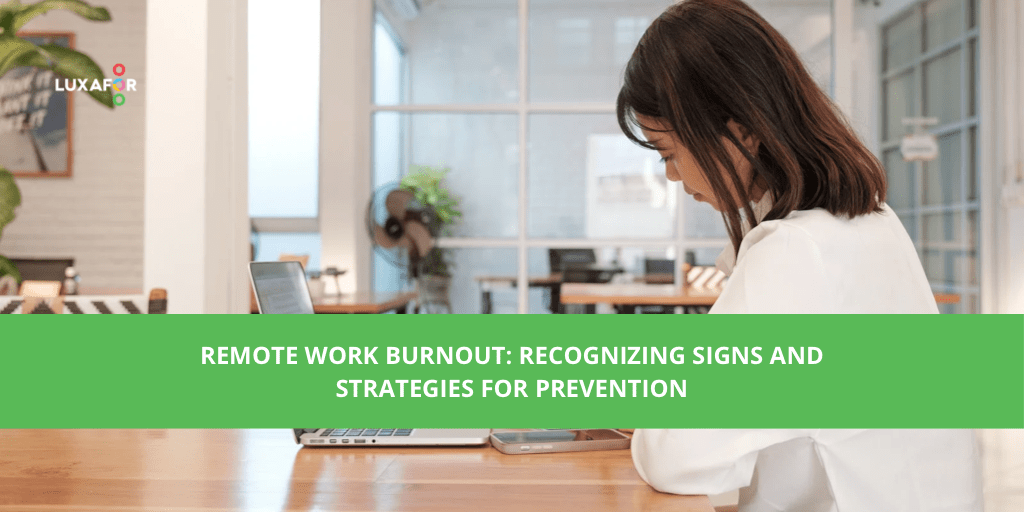Remote Work Burnout: Recognizing Signs and Strategies for Prevention
While many companies have returned to on-site work, remote arrangements remain the norm for others. This type of working arrangement has shown numerous benefits, and many employees take up this opportunity when offered. A 2022 McKinsey survey found that 87 percent of employees prefer to work remotely if an employer provides this option.
However, despite the benefits of remote working, workers might still experience negative feelings that lead to burnout. Read below to learn more about burnout and how to manage these feelings in a remote work setting.
What is burnout?
Remote work has many advantages, such as saving time and money on commutes and working virtually anywhere. However, despite the convenience and flexibility this work arrangement offers, many employees still reported experiencing burnout.
A 2021 survey found that over half (52 percent) of the respondents experienced burnout that year. This figure was a significant increase from their pre-COVID statistics, which was 43 percent.
Burnout refers to the state of emotional, physical, and mental exhaustion caused by prolonged stress. We often associate it with work responsibilities, especially if someone has a high-stress job or works in an incredibly demanding environment.
When you experience burnout, you often feel overwhelmed, cynical, and detached. It can also come with a reduced sense of accomplishment or purpose. These feelings can impact work performance, relationships, and life outside of the job.
Recognizing Signs of Remote Work Burnout
Remote work still comes with the risk of burnout. It can creep up gradually, affecting your well-being and productivity. Here are some warning signs of burnout you may experience or observe in others:
Exhaustion
Remote work often blurs the boundaries between your work and personal life, making it challenging to disconnect and recharge. As a result, people can experience burnout, feeling exhausted due to the pressure to always “be on” and on call whenever needed.
Signs of exhaustion may manifest as persistent fatigue, difficulty sleeping, and a sense of being overwhelmed by tasks. When left unchecked, chronic fatigue and exhaustion can lead to physical symptoms and a decline in workplace performance.
Lack of productivity
Burnout can significantly impact productivity, causing a decline in performance and efficiency. Workers may struggle to focus, procrastinate on tasks, and experience difficulty in meeting deadlines.
When burnt out, simple workplace tasks can seem impossible and take a lot of time and energy.
Less engagement
Due to the lack of energy you may experience, engaging with your coworkers can be challenging and tiring. You could experience isolation and detachment from your colleagues and the organization.
Without the social interaction that comes with working on-site, remote workers might lose interest in engaging with the team. Signs of decreased engagement may include a lack of enthusiasm for work, reduced communication, and feelings of loneliness.
Cynicism
Most jobs require people to navigate complex tasks and responsibilities, which necessitates support from other team members. However, a remote working setup could be prone to disconnection, especially if the team lacks strong relationships and camaraderie.
This disconnect between the person’s job and its impact on their teammates and the organization can lead to cynicism. Signs of cynicism may manifest as growing negativity toward work tasks, a diminished sense of enthusiasm during team meetings, or resentment toward coworkers.
Depression
The isolation that often accompanies remote working arrangements can exacerbate depressive tendencies in some people. Without the daily interactions and support networks in physical office spaces, remote workers may experience loneliness and disconnection.
These feelings of depression can worsen if a person lacks social interaction and support systems in their lives outside of work.
Symptoms of depression that include persistent sadness, hopelessness, and difficulty concentrating can significantly impact work performance and overall well-being.
Sleep problems
The flexibility of remote work schedules can blur the boundaries between professional and personal life. A lack of boundaries could impact people’s energy levels, sleep patterns, and the quality of their rest.
Remote workers sometimes struggle to maintain a healthy and consistent sleep schedule and experience difficulty falling or staying asleep. This could cause people to wake up feeling tired and unrefreshed.
Sleep disturbances can profoundly affect cognitive function, mood regulation, and productivity. You may experience low energy levels throughout the day, find it difficult to focus on your tasks, or become more irritable toward daily inconveniences.
Ways To Prevent and Recover From Burnout
As remote work becomes increasingly prevalent, it’s crucial to prioritize strategies for preventing and recovering from burnout. Anyone can experience burnout, and recovery can be challenging, especially as it affects all aspects of your life and well-being.
Below, let’s explore five ways to maintain good health and productivity in a remote working environment.
1. Set boundaries
Remote work can make distinguishing between your professional and personal life difficult, so it’s crucial to establish clear boundaries. This step is essential to help you focus during work and relax in your free time.
Set specific work hours and communicate them to colleagues, supervisors, and family members. You can also establish a dedicated workspace that is free from distractions and allows you to signal the start and end of each workday.
By defining boundaries, you can protect your time and minimize the chances of burnout.
2. Recognize stress
Stress is a common precursor to burnout, and recognizing its early signs is crucial to prevent it. Check-in with yourself and how you’re feeling from time to time. Be mindful of physical, emotional, and behavioral signs of stress, such as muscle tension, fatigue, irritability, and changes in sleep patterns.
By acknowledging stress early on, you can take proactive steps to address and prevent it from escalating into burnout. Your steps could include taking breaks or incorporating software tools to boost productivity and manage your time better.
3. Reach out to your support system
Remote work can sometimes feel isolating since you don’t get the daily socialization that an in-person workplace can offer. This induced isolation makes maintaining connections with your loved ones essential.
Contact friends, family members, or trusted colleagues for support and encouragement. Schedule regular meetups or phone calls to stay connected and share your experiences.
Having a support system to lean on during challenging times can provide valuable perspective and help alleviate feelings of isolation and burnout.
4. Take breaks
Breaks require you to step back from work. While they might seem counterintuitive, they are essential for maintaining productivity and overall wellness.
Add regular breaks into your workday to rest and recharge. Step away from your workspace, take a short walk, or do other relaxing activities to clear your mind. These short periods help ensure you don’t become overwhelmed by continuous work demands.
5. Exercise the body and mind
Physical activity and mental relaxation techniques are powerful tools for preventing and recovering from burnout. Prioritizing your psychological and physical well-being allows you to build resilience and manage the effects of burnout.
Incorporate regular physical activity into your routine. You can do yoga, go on walks or runs, or go to the gym in your free time. These practices can help reduce stress and boost your mood.
You can practice mindfulness meditation, deep breathing exercises, journaling, and other relaxing activities to care for your mind. Hobbies like reading or knitting can promote mental clarity.
Overcome Stress and Burnout
Burnout can be extremely challenging to overcome, especially when you’re in the depths of it. However, recovery is possible. Preventing and getting over burnout requires a commitment to your boundaries and self-care practices.
Understanding burnout and practicing the tips outlined above can help you sustain a healthy work-life balance and thrive in a remote work environment.
LUXAFOR HELPS PEOPLE TO ACHIEVE THEIR GREATEST PRODUCTIVITY LEVELS WITH A WIDE VARIETY OF OFFICE PRODUCTS. LET’S BE PRODUCTIVE TOGETHER!


















